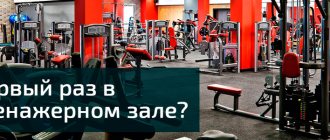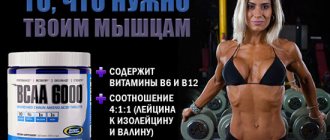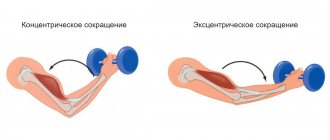How much rest between sets[edit | edit code]
It would seem like an elementary question, to which a clear and unambiguous answer should have been found long ago. However, the optimal duration of rest between approaches (sets) in bodybuilding remains unclear to this day. There are hundreds of articles written on this topic, and each of them has many copies, but very few of them reveal the scientific basis that allows us to understand what factors influence the duration of rest when gaining muscle mass, training for strength or endurance.
First of all, in order to get to the essence of the problem, you need to know the elementary energy processes in the muscles.
To describe it briefly: there are several energy sources in a muscle that are sequentially included in the work. In the first seconds, ATP begins to be consumed, after it is depleted, creatine phosphate begins to be used. It lasts for 30-40 seconds of intense muscular work; in parallel with this process, anaerobic glycolysis begins after 7-10 seconds. Next, glucose begins to be used, which undergoes aerobic glycolysis. When doing bodybuilding, sufficient muscle contraction strength can only be obtained while using creatine phosphate and ATP, then strength indicators decrease so much that continuing the exercise becomes pointless.
Theoretical aspects[edit | edit code]
The complexity of the issue lies in the fact that the mechanisms of muscle growth are still not precisely known.
According to the theory of microtrauma, muscle growth, and therefore an increase in strength, is stimulated by lifting heavy weights, which can only be achieved with fully restored reserves of ATP and creatine phosphate. Therefore, rest between approaches should be at least 2 minutes. The optimal time is 2-3 minutes.
According to the theory of cumulative fatigue, muscle growth is stimulated by the accumulation of muscle waste, primarily lactic acid. In this case, the rest period should be less than 1 minute. The optimal time is 30 seconds - 1 minute.
Currently, most strength programs recommend resting between sets for 2-5 minutes, and programs for increasing muscle mass - from 30 seconds to 1.5 minutes. This is due to a study that showed that a short period of rest caused a greater rise in growth hormone and testosterone levels. However, it was later shown that this does not affect muscle growth. This is most likely due to the short-term effect. In addition, with a short period between sets, the level of the hormone cortisol increases, which inhibits muscle growth.
The situation remained unclear until definitive studies were completed.
New research[edit | edit code]
The above-mentioned theoretical aspects are exaggerated in almost every article, and their inconsistency and mutual exclusivity do not allow us to find a general consensus. Let us turn to the studies that experimentally tried to find out the truth:
- SIMAO, R.; POLITO, M.; MIRANDA, H.; CAMARGO, A.; HOELLER, H.; ELIAS, M.; MAIOR, AS Analysis of different rest intervals between sets in strength training program. Fitness & Performance Journal, v.5, n. 5, p. 290-294, 2006.
Quote from the conclusion:
In this experiment, lasting 1 month, training frequency 3 times a week, the subjects performed strength exercises (biceps curls and bench press), while one group rested 1 minute between sets, and the other 3 minutes. We concluded that there were no significant differences in strength after 4 weeks of training.
- Belmiro Freitas, Simão, Roberto, Miranda, Fabrício, da Silva Novaes, Jefferson, Lemos, Adriana, Willardson, Jeffrey M. Rest Interval between Sets in Strength Training. Sports Medicine: 1 September 2009 – Volume 39 – Issue 9 – pp 765-777
Quote from the conclusion:
Indirect evidence suggests that to improve muscular endurance, the rest period between sets should be shorter than 1 minute. However, a rest period of 3-5 minutes can be considered safer.
- Martim Bottaroa, Breno Martinsb, Paulo Gentila, Dale Wagner. Effects of rest duration between sets of resistance training on acute hormonal responses in trained women. Sports Medicine Australia. Received 24 July 2007 Pages 73-78 (January 2009)
Quote from the conclusion:
The study tested changes in hormone levels (cortisol and growth hormone) after training, depending on the length of rest between sets. One group of athletes took a break of 30 seconds, the second - 60 seconds, and the third - 120 seconds. Immediately after exercise, growth hormone and cortisol levels were higher in the 30-second rest group, but no differences were found in the 1- and 2-minute rest groups. Note: Only 12 well-trained women took part in the study.
- de Souza Jr, TP, Fleck, SJ, Simão, R, Dubas, JP, Pereira, B, de Brito Pacheco, EM, da Silva. Comparison Between constant and decreasing rest intervals: influence on maximum strength and hypertrophy. Journal of Strength & Conditioning Research: July 2010 - Volume 24 - Issue 7 - pp 1843-1850
Quote from the conclusion:
During an 8-week experiment, two groups of athletes performed strength exercises on different muscle groups with different rest periods between sets.
The first group took 2 minute breaks. The second group gradually reduced the rest period from 2 minutes to 30 seconds over 6 weeks. As a result, it was found that in the two groups there are no significant differences in strength indicators and the amount of muscle mass gain, which means that there is no particular importance in the duration of rest between approaches.
- Gentil, P, Bottaro, M, Oliveira, E, Veloso, J, Amorim, N, Saiuri, A, and Wagner, DR. Chronic effects of different between-set rest durations on muscle strength in nonresistance trained young men. J Strength Cond Res 24(1): 37-42, 2010
Quote from the report:
For 12 weeks, untrained students, divided into 2 groups, performed strength exercises of 8-12 repetitions with various rest periods.
The first group rested according to the principle of a work-to-rest ratio of 1 to 3, and the second group - 1 to 6. When summing up the results, it was determined that there were no significant differences in strength indicators between the first and second groups.
Conclusion[edit | edit code]
As the latest research from 2010 showed, the time you spend resting between sets does not affect strength performance and the rate of muscle growth. Therefore, you can rest for as long as you need to fully perform the next exercise or set. So in bodybuilding, the optimal time can be considered 1-3 minutes between approaches. In powerlifting, breaks can be taken longer, until the creatine phosphate depot is completely restored - up to 5-6 minutes. If you want to increase your endurance, keep rest periods shorter than 30 seconds between each set.
conclusions
It seems clear that resting 1 minute between sets has a negative impact on muscle growth. However, if 1 minute of rest between sets is too little, then how long should you rest between sets if your goal is maximum muscle growth? Well, based on data from our previous experiment with experienced trainees, 2 minutes of rest between sets will likely be sufficient for recovery without negatively impacting muscle growth .
It is worth noting that the results of the current study need to be understood in the correct context, because we examined the effect of only 2 variations (1 min. vs. 3 min.) of rest in relation to the adaptations that occur in the muscles. However, this information shouldn't be taken as either black or white—there's no reason why you can't combine different rest intervals to potentially maximize hypertrophy.
A viable strategy is to rest longer during multi-joint, large muscle group exercises such as squats, presses, and deadlifts. These exercises cause very high metabolic stress, especially when performed in the moderate (8-15) repetition range. Thus, longer rest periods are required to fully restore energy before the next set. This will allow you to maintain your training volume throughout your workout .
On the other hand, single-joint exercises are not as metabolically taxing, so you can recover faster from set to set. For this reason, exercises such as triceps curls or leg extensions can likely be performed with shorter rest intervals between sets.
In this scenario, it is best to leave short rest exercises until the end of the workout to ensure that they do not interfere with recovery or affect physical performance during multi-joint exercises.
Final word: this topic is still being studied and each study is just a piece of the puzzle. As more experiments are conducted, I hope that we will soon have a better understanding of how to tailor a training program to achieve the maximum muscle growth possible. Follow the news.
Source: Brad Schoenfeld: What is the Ideal Rest Interval for Muscle Growth? Implications from Our Recent Study.
Rest between sets when training strength[edit | edit code]
Source: "Training Programs"
, scientific ed.
Author:
Professor, Doctor of Science Tudor Bompa, 2020
Energy is, of course, the most important component of strength training. During training, an athlete mainly uses energy generated by a specific energy system of the body in accordance with the load applied and the duration of the activity. During high-intensity strength training, a large amount of energy is consumed, until it is completely depleted. Thus, in order to perform the required amount of work, athletes need a rest break in order to replenish the expended energy before performing the next set.
Accordingly, rest breaks between sets and training sessions are as important as the training itself. The amount of time between sets largely determines how much energy can be recovered before the next set. So, carefully planning your rest break is the key to eliminating unnecessary physiological and psychological stress during training.
The length of the rest period depends on several factors, including the force combination being developed, the load applied, the time the repetition is performed, the duration of the set, the number of muscles used, and the athlete's fitness level. The athlete's body weight should also be taken into account, as heavy athletes with more muscle mass recover more slowly than lighter athletes.
Rest break between sets[edit | edit code]
The rest period is a function of the load applied during training and the type of force developed, and is particularly dependent on reserve (see Table 1).
Table 1. Recommendations for using rest breaks between sets
| Intensity zone | Load | %repetition max | Concentric failure (no reserve) or level close to concentric failure (small reserve) | Rest break (minutes) | Level far from concentric failure (high reserve) | Rest break (minutes) |
| 1 | Super Max. | >105 | Relative strength | 4-8 | — | — |
| 2 | Max. | 90-100 | 3-6 | Max, strength (90-95% rep max | 2-4 | |
| 3 | High | 85-90 | Absolute Power | 2-4 | Max, Strength and Power (High Load) | 2-3 |
| 4 | 80-85 | |||||
| 5 | Average | 70-80 | Hypertrophy | 1-3 | 1-3 | |
| 6 | 50-70 | Muscular endurance | 0,5-2 | Power (low load) | ||
| 7 | Low | 30-50 |
During the rest break, energy-rich substances, namely adenosine triphosphate (ATP) and creatine phosphate (CP), are restored in proportion to the length of the rest break. With the correct timing of the rest break, creatine phosphate levels are fully or almost completely restored and lactic acid builds up more slowly, allowing the athlete to maintain energy production throughout the workout. If the rest period is less than one minute, the lactic acid concentration becomes high; If the rest period is less than 30 seconds, lactate levels become intolerable even for well-trained athletes. On the other hand, if you properly determine the duration of the rest break, the accumulation of lactic acid is reduced and its removal from the muscles is facilitated.
In some sports, athletes need to withstand the effects of lactic acid. Examples include sprinting, swimming, rowing, canoeing, some team sports, boxing and wrestling. When conducting strength training in these sports, the following factors must be taken into account.
- During a thirty-second rest break, about 50 percent of the spent ATP-CP is restored.
- A one-minute rest break between several sets of 15-20 repetitions is not enough to restore energy sources and ensure high levels of energy production (see Table 8.13).
- Fatigue that accumulates during maximal strength exercises with insufficient rest periods leads to a decrease in the frequency of nerve impulses sent by motor neurons, resulting in a decrease in speed. This effect is not observed if the duration of the rest break is three to five minutes[1]; in fact, during a rest break of three minutes or more, ATP-CP reserves are restored almost completely.
- Longer rest breaks (more than three minutes) allow for better hamstring strengthening[2].
Rice. 1. Comparison of energy production for each repetition of five sets of 10 repetitions performed to failure and ten sets of 5 repetitions not performed to failure.
- When performing sets to concentric failure, it is necessary to allow much longer rest breaks compared to sets not performed to concentric failure. For example, performing a set of 5 reps at 70 percent of your RM load (15 percent reserve) may require one to two minutes of rest to replicate a similar level of energy production, whereas using a similar load to failure with reps ranging from 12 to 15 rest break may exceed five minutes to repeat the same average level of energy output, which will, of course, be lower than when performing a set of 5 repetitions (see Figure 1). After an athlete has worked to failure, a four-minute rest period is not enough to remove lactic acid from the working muscles or to replenish all energy sources such as glycogen.
Additionally, energy production and metabolic profile may differ between the following two variations: 5 sets of 10 reps to concentric failure versus 10 sets of 5 reps without work to concentric failure using a similar load as a percent rep max[3]. When not working to failure, there was a higher average energy output, more ATP after the last set (6 mM vs. 4.9 mM), higher CP (14.5 vs. 3.1 mM), and lower lactate levels. (5.8 millimoles vs. 25 millimoles). See Figure 1 and Table 2.
The degree of ATP-CP recovery between sets depends on the length of the rest break: the shorter the rest break, the less ATP-CP is restored and, accordingly, the less energy that can be used during the next set. Thus, one of the consequences of inappropriately long rest periods is over-reliance on the lactate system as an energy source. If the rest period is too short, most of the energy used in subsequent sets is supplied by the lactate system. Activation of this body's energy system results in decreased energy production and increased accumulation of lactic acid in working muscles, causing the athlete to feel pain and fatigue and reducing the athlete's ability to train effectively.
Table 2. Metabolic response to five sets of 10 repetitions performed to failure and ten sets of 5 repetitions not performed to failure.
| 10 REPS | 5 REPS | |||||
| Before | After 1 episode | After the final episode | Before | After 1 episode | After the final episode | |
| ATP | 6,46±0,56 | 6,42±0,57 | 4,90±0,39 | 6,58±0,35 | 6,19±0,59 | 6,09+0,41 |
| ADF | 0,86±0,03 | 0,91 ±0,10 | 0,92±0,11 | 0,86±0,04 | 0,89+0,08 | 0,87±0,08 |
| AMF | 0,07±0,04 | 0,09±0,03 | 0,09±0,04 | 0,08±0,04 | 0,08±0,03 | 0,08±0,03 |
| OAN | 7,37±0,59 | 7,42+0,67 | 5,91±0,44 | 7,52±0,36 | 7,16±0,66 | 7,04±0,49 |
| IMF | 0,01±0,00 | 0,08±0,11 | 0,87±0,69 | 0,01 ±0,00 | 0,01±0,00 | 0,01±0,02 |
| FKr | 21,0±8,86 | 7,75±5,53 | 3,15±2,88 | 19,5±4,06 | 11,68±7,82 | 14,47±7,24 |
| Kr | 8,93±4,96 | 25,45±3,80 | 22,90±6,89 | 8,40±3,25 | 16,97±6,33 | 15,57±5,01 |
| FKr+Kr | 29,91±5,19 | 34,55±6,23 | 26,06±8,44 | 27,90±3,65 | 30,56±6,19 | 30,15±8,46 |
| La | 1,70±1,18 | 17,20±3,50 | 25,01 ±8,09 | 2,02±1,05 | 7,10±2,54 | 5,80±4,62 |
| Change energy | 0,933±0,006 | 0,927±0,004 | 0,909+0,014 | 0,932+0,007 | 0,927±0,006 | 0,928±0,006 |
Legend: ATP - adenosine triphosphate, ADP - adenosine phosphate, AMP - adenosine monophosphate, TAN - total adenine nucleotide, IMP - inosine monophosphate, FKr - phosphocreatine, Kr - creatine, La - lactate.
Thus, unless the training goal is hypertrophy or lactate tolerance, the athlete requires a longer rest period to maintain energy production levels and counteract excessive lactic acid accumulation.
Another consequence of an inappropriate rest period is localized fatigue of the muscles and central nervous system. In accordance with the results of most scientific works, the following possible causes and sources of fatigue are identified.
Motor neuron[edit | edit code]
The nervous system transmits impulses to muscle fibers through a motor neuron. A nerve impulse has a certain frequency. The higher the frequency of the nerve impulse, the stronger the muscle contraction, which allows the athlete to lift more weight or rapidly apply force during a sprint. The frequency of nerve impulses is significantly affected by fatigue, in particular, with an increase in the level of fatigue, the force of contraction decreases as a result of a decrease in the frequency of nerve impulses [4] [5]. Thus, to restore the nervous system at the stage of maximum load, it is necessary to use longer rest breaks (up to eight minutes).
Neuromuscular synapse[edit | edit code]
Neuromuscular junction
represents the point of connection between the nerve and muscle tissue, which transmits nerve impulses to working muscles. Fatigue at this point is mainly a consequence of increased production of chemical mediators (i.e., neurotransmitters) by nerve endings[6]. The electrical properties of the nerve usually return to normal if the athlete rests for two to three minutes after performing a set. However, after performing the powerful contractions associated with maximal strength/maximum load training or speed/endurance training, a rest period of more than five minutes may be required for full recovery.
Mechanisms of muscle contraction[edit | edit code]
The mechanisms of muscle contraction (the basis of which is the interaction of actin and myosin) can also be the point of occurrence of fatigue and impairment of the athlete's performance. Specifically, due to the increased acidity levels caused by continuous high-intensity muscle contractions, the level of maximum tension, or the ability of the muscle to contract with maximum force, is reduced and the muscle's ability to respond to nerve impulses is affected[7][8]. Fatigue of the contracting muscle also occurs as a result of depletion of muscle glycogen stores, which occurs during prolonged exercise (lasting more than 30 minutes)[8][9][10]. Alternative energy sources, such as glycogen stores in the liver, cannot fully satisfy the energy needs of working muscles.
The central nervous system can also be affected by localized fatigue; in fact, such fatigue is typical of sets performed to concentric failure. During exercise, chemical disturbances occur within the muscle that affect the muscle's ability to perform work[11][12]. When the central nervous system receives a signal about the effects resulting from these chemical disturbances, the nerve impulses sent by the brain to the working muscles are weakened, reducing the muscle's ability to protect the body. By using an appropriate rest break of three to five minutes, the muscles recover almost completely. The brain sends a signal that there is no threat to the body and sends stronger nerve impulses to the muscles, which improves their performance.
Alternating load and rest
And before we begin, I propose to understand why alternating load and rest in bodybuilding is generally used, because we do a set, then we rest, then we do a set again and rest again, etc.
This is the alternation of load and rest. So, what is this for? =)
The answer is simple: all loads in bodybuilding are repeated after a certain amount of rest time, because this method is used to have a stronger impact on the trained function.
Therefore, rest is an integral part of the training process, and that is why, below, I give the basic rules of what rest should be like in bodybuilding:
- Rest should be sufficient to restore your strength so that you can repeat the next set at a sufficient power level.
- Rest should ensure that the concentration of lactic acid in the muscles decreases so that the muscle can again reach its maximum rate of energy expenditure.
That is why each subsequent approach is less effective than the previous one due to the gradual decrease in contraction power due to the residual accumulation of acidic metabolic products in the muscle.
And for those who are not in the know, complete removal of lactic acid from the muscle is ensured only after several hours after exercise, but only a few minutes are enough to significantly reduce the concentration of lactic acid in the muscle.
This is why the classic rest between approaches in bodybuilding is considered to be 1, maximum 2 minutes, no more (ideally, as you train, the rest should be shortened and shortened, reaching 30 seconds).
Because during this time, lactic acid, of course, will not be completely eliminated, but will decrease to such a level that you can do the next approach fully (at a sufficient power level).
The advantages of this period of time also lie in the fact that you are working on gaining muscle mass and increasing endurance at the same time, thereby killing two birds with one stone.
What to do during breaks[edit | edit code]
Aerobic activity with a maximum oxygen consumption rate of 20% during recovery between high-intensity bouts of intermittent exercise (lactate bouts) has a more positive effect on performance during subsequent bouts compared to stretching or passive rest[13]. Performing relaxation exercises (such as shaking your legs, arms, and shoulders) or gentle massage can also help speed recovery between sets. In addition, athletes can move on to another type of activity, which involves light work of muscles not involved in the process of performing the main exercise. Research shows that this activity accelerates the recovery of prime mover muscles[14].
Static stretching of muscle groups that are planned to be used during a strength training session should not be performed unless such stretching is practiced at the beginning of a long warm-up with a gradual increase in intensity, since otherwise acute blocking of muscle performance may occur[15][16] [17][18][19][20]. The purpose of stretching is to artificially lengthen the muscle by overlaying myosins and actins. The faster the muscles return to their normal length, the sooner their recovery and regeneration will begin and, thus, the process of removing metabolic waste accumulated during training will be simplified. Static muscle stretching should be planned for the end of the training session.
Read also[edit | edit code]
- Training program for beginners
- Training program for professionals
- Optimal training duration
- Optimal training frequency
- Recovery after training
- Muscle balance and the basics of training
- Number of repetitions for mass and strength in the exercise
- Number of approaches per muscle group
- Gradual increase in load
- Training Volume
- Strength Training Intensity
- How many repetitions to do in a set
- How many approaches to do
- How many times a week to train
- How many exercises to perform for one muscle group
- How long to rest between sets
- Rest between exercises and sets
- Exercise speed
- How often to exercise
- Order of exercises
Exercises, muscle groups and rest
The fact is that different exercises for different muscle groups also affect the rest between approaches. Those. you should also know about this and take into account that:
- The more effort an exercise requires, the more rest you need to give (these are mostly basic multi-joint movements, such as squats, deadlifts, leg presses, pull-ups, etc., in general, very difficult exercises) .
- The less effort an exercise requires, the less rest it requires (for the most part these are isolating movements, but basic movements are not excluded, there are basic movements, for example, lifting a barbell for biceps (in fact, it involves only one joint, the elbow), therefore, the exercise is not that difficult, but is considered basic), arm extensions at the block, standing calves in the machine / sitting calves, etc. in general, not such heavy movements.
If we look at it from the point of view of muscle groups, this is what it will look like:
Large muscle groups = more rest, small ones = less
In fact, I didn’t tell you anything new, but still (it will be useful to many).
In general, the classic rest between approaches (in bodybuilding) is 1-2 minutes, no more.
- For heavy exercises and large muscle groups = more rest can be given.
- For lighter exercises and smaller muscle groups = less rest.
All this is a guideline for the initial and intermediate level of athletes’ preparedness.
As for professionals (advanced athletes, for those who really train seriously, and there are very few of them, I would say “a few”), they already know this 100% (that’s why they are advanced), but specifically for them, you can “forget about guideline 1-2 minutes,” and try the same unsafe method of load progression in the form of increasing the amount of work done during a workout. Now, I will explain again, but in more detail.
Sources[edit | edit code]
- Bigland-Ritchie, B., Johansson, R., Lippold, OCJ, and Woods, JJ 1983. Contractile speed and EMG changes during fatigue of sustained maximal voluntary contractions. Journal of Neurophysiology 50(1): 313-24.
- Pincivero, D. M., Lephart, S. M., and Karunakara, R. G. 1997. Effects of rest interval on isokinetic strength and functional performance after short-term high intensity training. British Journal of Sports Medicine 31(3): 229-34.
- Gorostiaga, E.M., Navarro-Amezqueta, I., Calbet, J.A., Hellsten, Y., Cusso, R., Guerrero, M., Granados, C., Gonzalez-Izal, M., Ibanez, J., and Izquierdo, M. 2012. Energy metabolism during repeated sets of leg press exercise leading to failure or not. PLOS One 7(7):e40621. doi: 10.1371/journal.pone.0040621.
- Ranieri, F. and Di Lazzaro, V. 2012. The role of motor neuron drive in muscle fatigue, Neuromuscul Disord 22(3): S157-61.
- Taylor, J. L., Todd, G., and Gandevia, S. C. 2006. Evidence for a supraspinal contribution to human muscle fatigue, Clin Exp Pharmacol Physiol 33(4): 400–5.
- Tesch, P. 1980. Muscle fatigue in man. Acta Physiologica Scandinavica Supplementum 480:3–40.
- Fox, E.L., Bowes, R.W., and Foss, M.L. 1989. The physiological basis of physical education and athletics. Dubuque, IA: Brown.
- ↑ 8.08.1 Sahlin, K. 1986. Metabolic changes limiting muscular performance. Biochemistry of Exercise 16:86–98.
- Conlee, RK 1987. Muscle glycogen and exercise endurance: A twenty-year perspective. Exercise and Sport Sciences Reviews 15:1-28.
- Karlsson, J., and Saltin, B. 1971. Diet, muscle glycogen and endurance performance. Journal of Applied Physiology 31(2): 203-6.
- Bigland-Ritchie, B., Johansson, R., Lippold, OCJ, and Woods, JJ 1983. Contractile speed and EMG changes during fatigue of sustained maximal voluntary contractions. Journal of Neurophysiology 50(1): 313-24.
- Hennig, R., and Lomo, T. 1987. Gradation of force output in normal fast and slow muscle of the rat. Acta Phys- iologica Scandinavica 130:133–42.
- Dorado, C., Sanchis-Moysi, J., and Calbet, J. A., 2004. Effects of recovery mode on performance, 02 uptake, and 02 deficit during high-intensity intermittent exercise. Canadian Journal of Applied Physiology 29(3): 227-44.
- Asmussen, E., and Mazin, B. 1978. A central nervous system component in local muscular fatigue. European Journal of Applied Physiology 38:9-15.
- Power, K., et al. 2004. An acute bout of static stretching: Effects on force and jumping performance. Medicine and Science in Sports and Exercise 36 (8): 1389-96.
- Cramer, J. T., et al. 2005. The acute effects of static stretching on peak torque, mean power output, electromyography, and mechanomyography. European Journal of Applied Physiology 93(5-6): 530-39.
- Nelson, A.G., et al. 2005. Acute effects of passive muscle stretching on sprint performance. Journal of Sports Sciences 23(5): 449-54.
- Yamaguchi, T., et al. 2006. Acute effect of static stretching on power output during concentric dynamic constant external resistance leg extension. Journal of Strength and Conditioning Research 20(4): 804-10.
- Samuel, M.N., et al. 2008. Acute effects of static and ballistic stretching on measures of strength and power. Journal of Strength and Conditioning Research 22(5): 1422-28. doi:10.1519/JSC.0b013e318181a3l4.
- La Torre, A., et al. 2010. Acute effects of static stretching on squat jump performance at different knee starting angles. Journal of Strength and Conditioning Research 24 (3): 687-94. doi:10.1519/JSC.0b013e3181c7b443.











